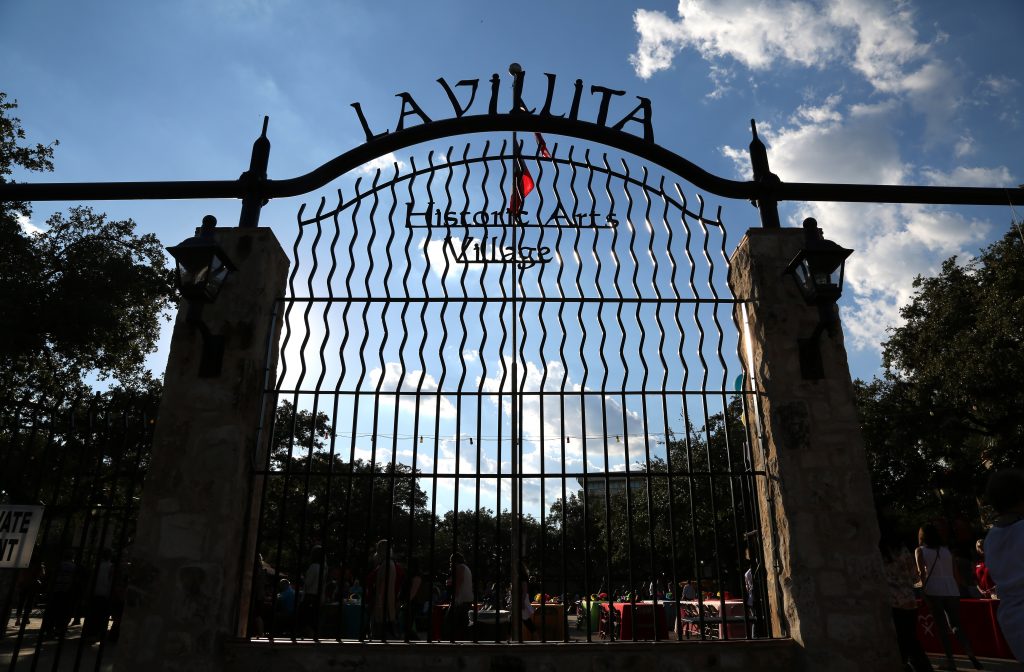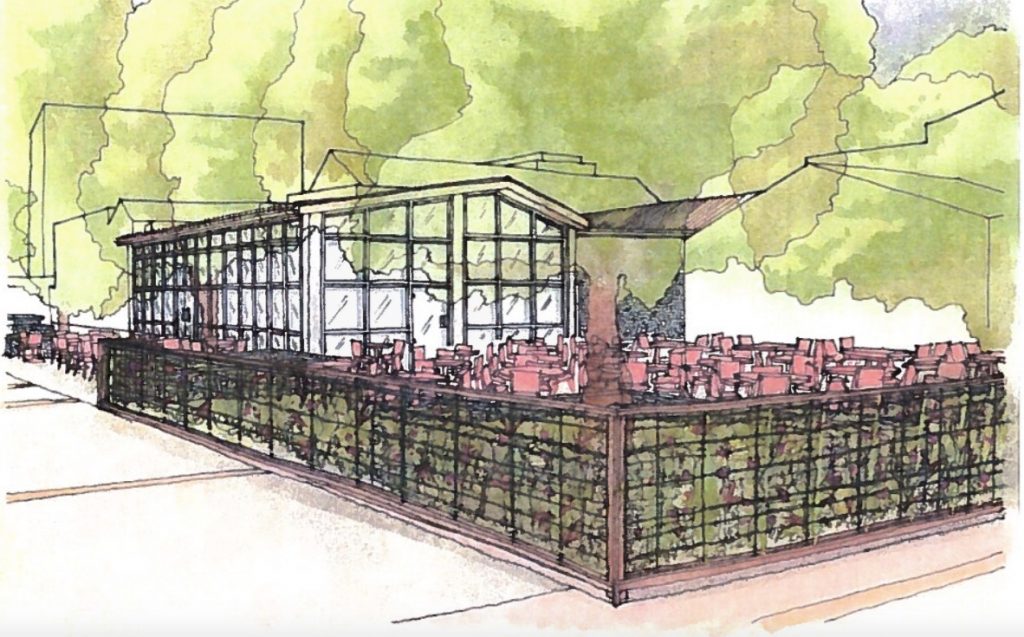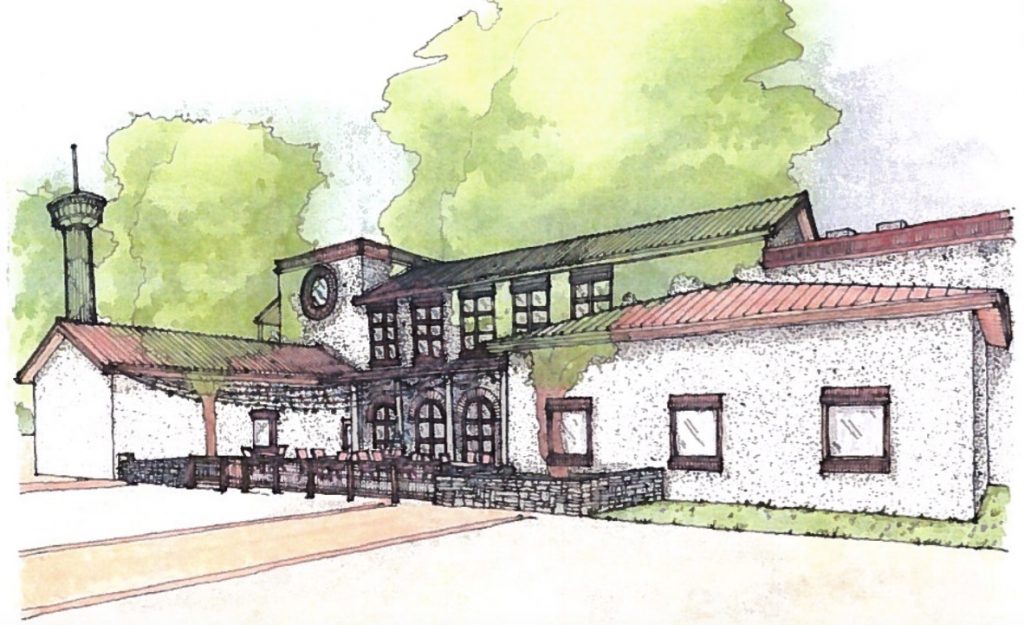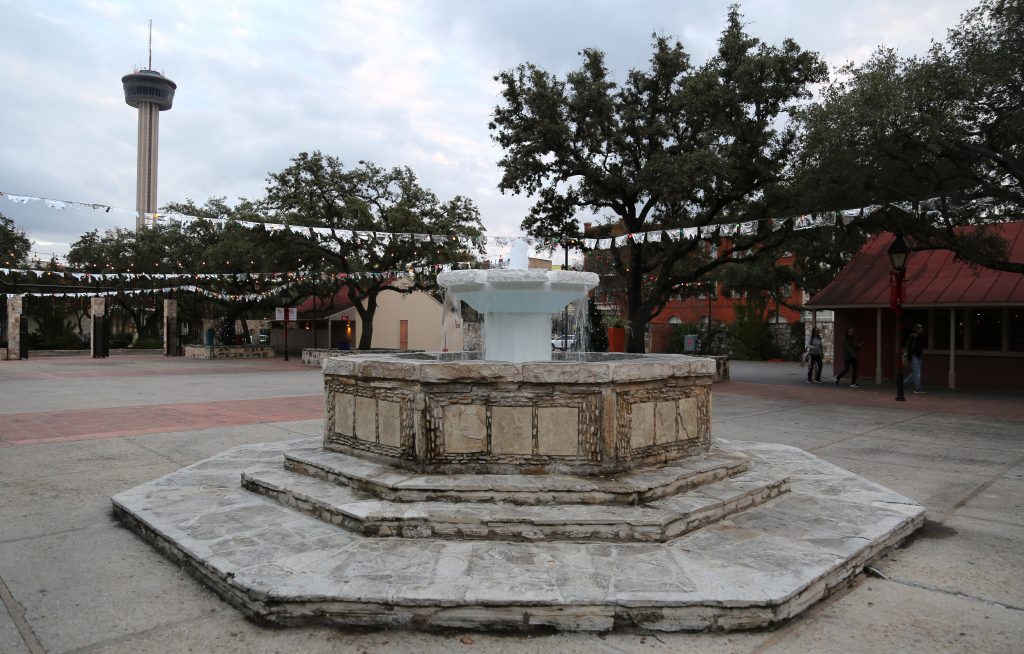
Unlike Alamo Plaza or Main Plaza, Maverick Plaza is more of an event space than a gathering place. When there isn’t a private event or celebration such as A Night in Old San Antonio (NIOSA) or Dia de los Muertos happening, the plaza is a desolate space tourists traverse to find the shops at La Villita.
A year ago, the City Council agreed to lease the plaza for 49 years to Grupo La Gloria, a restaurant group lead by prominent chef Johnny Hernandez. The plan: to transform sleepy Maverick Plaza into San Antonio’s next culinary destination—a $12 million makeover that will result in new Mexican, Spanish and German restaurants with outdoor patios; new pavings and furniture; outdoor kitchens and kiosks; more trees; better lighting.
It’s designed to tell San Antonio’s rich history through food and programming and to draw pedestrians into the seldom-used plaza.
“In my agreement, we said we would curate food history through our food and beverage program and cultural events,” Hernandez said. “That’s what is driving the heart and soul of La Villita—the food and art.”
But a few big questions linger a year after the city and Hernandez reached an arrangement.
Will there be enough space left over for large events or concerts after the renovations are completed? Conceptual drawings show the three restaurants and their 352 combined seats consuming Maverick Plaza’s margins, leaving only the center for future events.
How much of the programming will Hernandez control—and of that programming, from which events will he pocket the profits? How much profit does Hernandez and his partners expect to make on the restaurants?
Perhaps most important to Fiesta-goers: How will NIOSA be affected?
“We really don’t have any details,” said Susan Beavin, president of the San Antonio Conservation Society, which puts on the four-day event at La Villita every year. “We don’t even have renderings. They’re really just (concepts) for future restaurants.”
» Download the La Villita lease agreement between the city and Grupo La Gloria signed in May.
» Download a draft of the lease agreement approved by City Council on Dec. 14, 2017.
» Download the 64-page Maverick Plaza Master Plan, Oct. 7, 2017 (10MB)
The vision

Here’s a quick look at the major upgrades planned for Maverick Plaza. The restaurant construction and build-out will cost approximately $7.6 million, which Grupo La Gloria is funding. The $4.4 million in public upgrades, which include demolition of the 1970s limestone walls that surround the plaza; and the installation of new pavers, furniture, and other features; will come from the city’s Inner City Tax Increment Reinvestment Zone (TIRZ). TIRZ funding also includes $600,000 to be distributed over seven years to support programming.
The project is expected to be completed in July 2021.
A

The Faville House (circa 1855) will become Acequia, a Spanish restaurant by chef Elizabeth Johnson, owner of Pharm Table. The restaurant will interpret this region’s indigenous ingredients—such as mesquite, nopal, agarita, chile pequin and pecans—as well as ingredients introduced by the Canary Islanders when they arrived in San Antonio in 1731. An enclosed porch will be built into the plaza. The plaza’s limestone walls will be torn down, and an outdoor patio will face a promenade along Alamo Street, which will be reconstructed from Market Street to Chávez Boulevard using bonds dollars. The restaurant’s interior will be decorated “in the style of an Iberian cottage and will serve Spanish cuisine within its cozy stone rooms,” according to the master plan. Acequia will include 74 indoor seats and 202 outdoor seats.
B

This two-story Mexican restaurant, which Hernandez will lead, will be constructed anew on the southeast corner of the plaza—one story facing the plaza and two stories facing Nueva Street—and will be made to look like the historic buildings inside La Villita. The structures currently in that quadrant—the ’70s walls, the restroom building—will be razed. The new building’s exterior will be plaster accented by D’Hanis red brick. The interior “will reflect the elegance of a Mexican hacienda with beamed ceilings and tiled floors.” In it, Hernandez will serve flavors of the “Mesoamerican cultures of the Maya, meticulously exploring its evolution through the prism of Spanish colonization.” The unnamed restaurant will include 150 indoor seats and 56 patio seats.
C

The plaza’s concessions building will be torn down and replaced with a German restaurant, microbrewery and beer hall operated by Cured owner and chef Steve McHugh. “Its central space will open to the roof rafters and be tall enough to contain the vats and tanks of a microbrewery, which will be publicly displayed.” The restaurant will also use the neighboring Gissi House, 250 King Philip, a mid-19th century structure originally located in the HemisFair ’68 area that was dismantled and rebuilt at La Villita in 1969. Outside will be a 94-seat beer garden. Inside, the restaurant will have 132 seats.
D

Seating will surround the fountain at the plaza’s center, which may be replaced, according to the master plan. Four trees will also be planted around the fountain. Fountain seating will be available for people who purchase food from kiosks and demonstration kitchens dotted throughout the plaza and on the Alamo Street promenade.
E
Thirty angled park spots will be carved out along Nueva Street.
F

Alamo Street will be turned into a complete street, meaning it will be made to serve pedestrians, cyclists and motorists equally, using $9 million from the 2017-2022 bond program. The promenade (shown above) will also be revamped so that it blends in with Maverick Plaza on one side, and across Alamo toward Hemisfair on the other side.
The process
Soon after Fiesta ends next year, the city will begin preliminary infrastructure work on Maverick Plaza, which is home to NIOSA’s Frontier Town—the biggest moneymaker of the festival’s 14 sections spread throughout La Villita.
Based on a presentation to the council last year, the design of the plaza and the restaurants was supposed to happen between January and December of this year, but the work is just now getting started.
In 2017, Fisher Heck Architects completed a 64-page master plan of the plaza, which shows renderings and conceptual drawings of the entire plaza, including the restaurants. The document is more concept and historical context, than concrete plan.
Hernandez confirmed that Grupo La Gloria recently hired Fisher Heck, again, and MP Studios Landscape Architects to begin the actual design, and that work has now started. Final designs are expected to be completed in November 2019.
Between now and then, the city plans to invite the public to share feedback during open events, but neither Hernandez nor city officials could say when the public meeting process would start.
The City Council approved the lease on Dec. 14, 2017. The lease was signed in May. The architect team was just selected.
So, what’s been going on throughout 2018?
Grupo La Gloria has been “doing research and fact finding to understand the history of the space, and we will be designing something that is in line and respects everything about it,” Hernandez said.

Part of Hernandez’ charge is to keep in the spirit of Mayor Maury Maverick’s Oct. 12, 1939 ordinance, which restored La Villita from the slum it had become. In the ordinance, Maverick said La Villita “shall not and must not be a restoration and reconstruction of the dead past, and a ghost village for the mincing walk and dusty ways of scholars, but likewise for the average living citizen.”
Maverick Plaza wasn’t always Maverick Plaza. That corner of Alamo and Nueva street was home to commercial buildings for decades.
In the early 1970s, “Maverick Plaza was created as an outdoor venue for parties, conventions and other gatherings,” the master plan reads. It was walled with limestone in keeping with the tradition of enclosed plazas that prominent architect O’Neil Ford, who Maverick tapped for the restoration, applied at La Villita. Those others plazas are Plaza Nacional, Plaza Juarez, O’Neil Ford Plaza.
“This year the city was focussed on so many other things, we didn’t necessarily feel that Johnny Hernandez needed to be rushed,” District 1 Councilman Roberto Treviño said. “The place is still active and open. When things are ready to go, we expect to move quickly.”
Treviño said he was confident a public process would start “very soon,” and added that Hernandez played a key role in San Antonio securing UNESCO’s designation as a Creative City of Gastronomy—one of only two in the U.S. (The other is Tuscon, Arizona).
“Of course, any time you’re talking about city property and city assets, we should always have a way for the community to understand what’s going on, and where we are in that process,” Treviño said.
As part of the lease, Grupo La Gloria’s rent starts at $100,000, which will fund the plaza’s maintenance and programming.
Recently, the Heron filed an open records request seeking Grupo La Gloria’s business plan and pro forma for the project—to see what the organization’s return on its $7.6 million investment looks like. Grupo La Gloria has challenged the request with the Texas Attorney General’s office.
The Maverick Plaza strategy is the latest in an effort by the city to bring sustained life to La Villita.
In recent years, city officials attempted a similar plan, which would have brought more restaurants inside La Villita. In 2014, for example, the city proposed converting a two-story building, used by the Little Church of La Villita for its food pantry program, into a restaurant. But that suggestion was quickly shot down, and the distribution service continues to this day, Arthur Flores, food program minister for the church, said.
The other shop and gallery owners were forced to reapply for their leases. Some did. Others didn’t and just retired. Currently, the city is close to leasing two of the last three available of the 24 city-manage buildings at La Villita—the Hessler House and the Dosch-Rische House, both of which face Presa Street.
The programming

Unlike the lease agreement the city made with the state and the Texas General Land Office over Alamo Plaza, city officials insist Maverick Plaza will remain in full control of the city, even with Hernandez as its tenant.
[ Editor’s note: The Heron requested interviews with the city about Maverick Plaza, but none were granted. All correspondence was done by email with Center City Development and Operations Spokeswoman Kelly Saunders. ]
The city says it will partner with Grupo La Gloria to activate Maverick Plaza.
The lease that was ultimately signed in May, however, does not explain how that partnership will work.
Hernandez can close the plaza and Arneson River Theatre for eight days of the year for private events, according to the lease. Otherwise, the lease appears to provide Grupo La Gloria with full control of the plaza’s programming.
“Tenant hereby covenants and agrees to engage in regular public programming of Maverick Plaza including the newly constructed educational kitchens,” the lease reads.
No further details are included in the document. It mentions that the “terms and conditions of such public programming shall be governed by a separate Operational and Programming Agreement to be entered into by Landlord and Tenant.”
But that agreement has yet to be drafted.
“The Operational and Programming Agreement has not been written or negotiated yet, and so we have no responsive records for that request,” the Center City Development and Operations Department wrote in a recent email.
Then there’s the question of space. The conceptual drawings in the master plan show much of the plaza’s current footprint taken up by restaurants or their outdoor patios.
Hernandez acknowledged that some events traditionally held at Maverick Plaza may have to find new homes, such as Hemisfair across the street.
“Great events grow and evolve,” Hernandez said. “Hemisfair is going to be a great place to see events that have outgrown La Villita.”
Hemisfair CEO Andres Andujar agreed.
“As La Villita transforms itself … there will be events that may no longer be appropriate because they are too large for the space, and so the natural expansion for those types of events would be for Hemisfair,” said Andujar, who cited the Diwali festival as an event that originated at Maverick Plaza before moving to Hemisfair.

Some of these uncertainties weigh on minds at the San Antonio Conservation Society, the organization behind NIOSA, by far the largest event held a Maverick Plaza, and La Villita as a whole, every year.
Every Fiesta, the conservation society uses Maverick Plaza for its Frontier Town area of NIOSA. Parts of Nueva and Alamo street, just outside the plaza, are shut down for its NIOSA’s Clown Alley and French Quarter sections, respectively.
The uncertain outlook for NIOSA is reinforced by the fact that CPS Energy has put the circa-1959 Villita Assembly Building, home to its Sauerkraut Bend hall, and its Navarro building, which serves as one of NIOSA’s four entrances, up for sale.
“It’s not just Maverick Plaza, but the CPS building … La Villita Assembly Hall—all up for sale,” Beavin said. “If someone came in and decided they wanted to buy it, and not lease it to us … that could be a problem.”
Every year, NIOSA raises more than $500,000 for the city—nearly $200,000 feeds conservation efforts through the La Villita Fund, and the rest for NIOSA’s logistical expenses such as the hiring of police, Beavin said. It’s also the conservation society’s main fundraiser, which benefits building development and educational educational outreach programs, for residents, tourists and school-aged children.
Beavin said the conservation society’s strategic planning committee is looking at all the options regarding NIOSA’s future, “particularly during the construction period.”
Heron editor Ben Olivo contributed to this report.
Why not put a bridge that connects La Villita to the Hemisfair park across the street so pedistrians can walk across freely without having to use the crosswalks. Traffic would move faster too. They can also incorporate NIOSA with the Hemisfair park and there would be more space for that event.